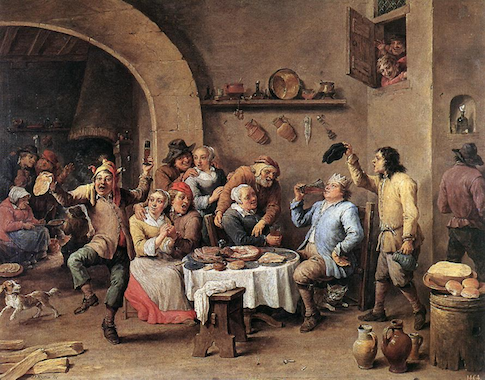It’s turtle doves today. Two of them we’re supposed to receive here on Saturday the 26th, the second day of Christmas, 2015. The turtle dove—as you know, of course—is the Streptopelia turtur: a member of the family Columbidae, a migratory species native to Europe and North Africa with a southern Palearctic migratory range. Smaller and slighter than non-turtley doves, I’m told, the turtle dove may be recognized by its brown color and the striped patch on the side of its neck.
And so "the voice of the turtle is heard in our land," the King James Version of Song of Songs (2:12) reports, either because turtles were especially noisy in the days of King Solomon or because the English in the early 17th century didn’t know many turtles personally and thought the creatures wouldn’t mind sharing their name with a bunch of doves. Actually, a little research will show that the words are unrelated: turtle for turtle doves is a Middle English imitation of the turturing sound the birds make, while turtle for turtles comes from the Latin tortuca for tortoise, via the French tortue. And, anyway, it was the doves we are supposed to get today, for the second day of Christmas, according to the song, not the ectothermic Testudines reptiles.
And that’s the point I was trying to make, before the Linnaean system of biological classification and the weirdness of English words distracted me. The twelve days of Christmas aren’t the run-up to Christmas, culminating in the smash-up of twelve drummers drumming on Christmas Day. They are the run of days in the season afterward, as Christmas reaches out toward the coming year.
This is what we’ve gotten wrong with the way we tend to do Christmas. The days before the holy day, the weeks marked with Advent candles, were intended to be penitential—a season of reflection and amends, with the celebration starting mostly on the actual day of Christ’s birth. Advent was intended to make us look forward to the parties, but we’ve turned the pre-Christmas days into the celebration itself. And what, then, are we supposed in the time right after Christmas? What are we supposed to do for the next twelve nights?
In the complexities of the Church calendar, Christmas Day is the end of the four weeks of Advent and the first of the days of Christmas, which run till January 5. And, as Shakespeare knew, that last Christmas evening is called Twelfth Night: the night before Epiphany and traditionally a time for skits and celebrations, with a Lord of Misrule appointed to lead the festivities.
The Christmas season gives us the feast of St. Stephen—Boxing Day in England, Wren Day in Ireland, and December 26 in the rest of the world. And then the feast of the Holy Innocents, the children slaughtered by King Herod. And then the feast of the Holy Family; Hogmanay, the feast of St. Sylvester; the Solemnity of Mary, the feast of the Holy Name, and all the rest.
I have written before on what a muddle it all is: Even in the Church calendar, the run from the first day of Christmas through to Epiphany and on to Candlemas has no clarity of narrative, no firmness of organization, and no sharpness of lesson—except, perhaps, in the sheer messiness of it all. Despite all the advertisements and canned carols that begin even before Thanksgiving, Advent is structured as a clean and penitential time. Christmas itself is the chaos.
But Christmas isn’t supposed to be tidy, and that’s rather the message that the Church conveys in the season. Christmas is supposed to radiate on through the next days, with the turtle doves and all the progressively more absurd and extravagant gifts named in the song. Christmas is one of those medieval festivals, which were always wild and unruly things—a theological center to it all, but wrapped around that center are layers and layers of mad celebrations, wild decorations, and boisterous song.
Layers and layers of joy, in other words. The Christmas season isn’t the calm of Christmas Eve and the silence of the Holy Night and all the rest of the whispered anticipations of Advent. Christmas is when the real thing has actually arrived—Christ, born in the flesh—and the time has come to celebrate.
Nearly everyone knows how to do Christmas Day. In our house, over the years, we folded together some of my wife’s parent’s traditions with some of my own parent’s traditions, seasoned by things that caught our eye or tastebuds: a Swedish dried-fruit soup for Christmas Eve and those round Danish pancakes called æbleskivers for Christmas morning. (Lots of Scandinavians, out in the Dakotas where I grew up.) A roast goose, sage stuffing, cranberries, and all the other trimmings for Christmas dinner. A tree with silver sleigh bells and glass ornaments, a mantel with stockings and a crèche. All the panoply of wreathes and bows and lights and bells. And my daughter is now the keeper of it all, the stern referee who insists on strict adherence to every jot and tittle of our Christmas traditions.
But it’s in the days after Christmas that we see Christmas unfold—the days of eggnog and leftovers. The jigsaw puzzles spread out on the folding table. The games and the skits. The annual ghost stories. The visits with the neighbors. The cold and the dry snow that crunches underneath your boots. It’s not coherent, and it’s not neat, anymore than that silly partridge in the pear tree makes much sense. But it is a sign of the Christmas truth about the great, mad joy that God brought into the world. And so I’ll take it—along with the two turtle doves I’m owed this morning.
